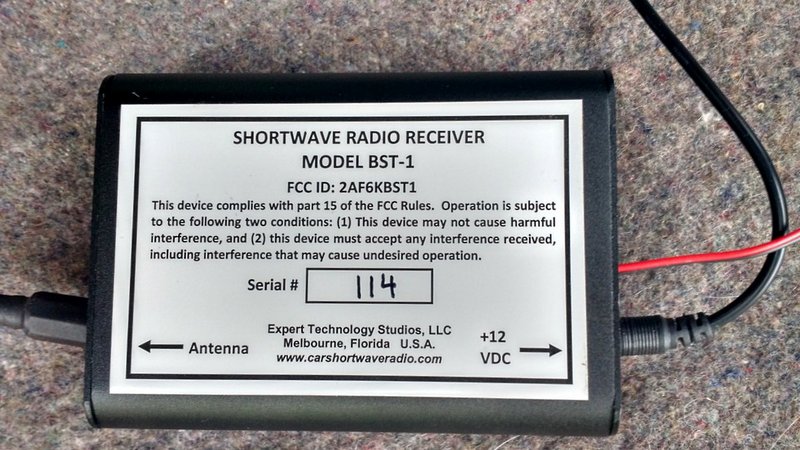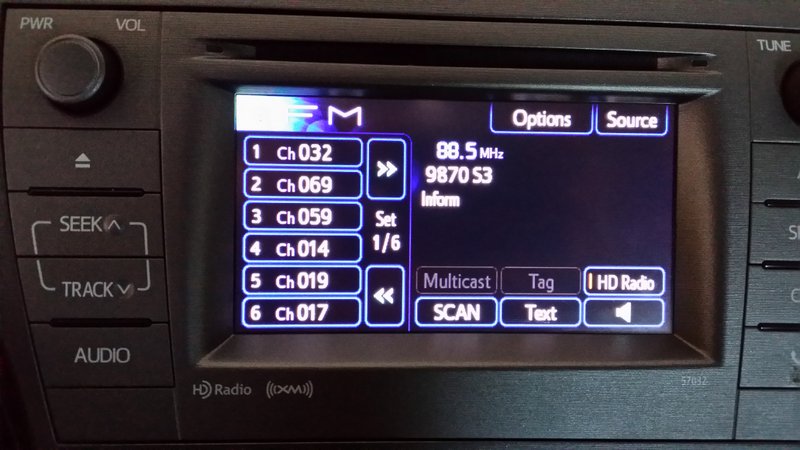 Many thanks to SWLing Post contributor, Matt, who shared this review of the BST-1 car shortwave receiver:
Many thanks to SWLing Post contributor, Matt, who shared this review of the BST-1 car shortwave receiver:
Overall: a good sensitive receiver, with a very inventive interface. I am looking forward to my long commutes for a change.
Using the FM RDS info on the car radio is a stroke of genius.
Performance: Miles ahead of my old MFJ 3 band heterodyne converter. I could hear 2 or 3 stations in the day, maybe 6 or 8 at night. With this new receiver during my morning and evening commutes in the NE US, I can hear dozens of stations day or night. Performance is roughly on par with a decent shortwave portable using the built in whip. I get 6070 Canada listenable 2 out of 3 days, 9580 Australia one out of 4 days in the morning, Radio Romania is an S5-8 beacon in the evenings.
Quirks: when the receiver is powered down, it does not save the music/speech bandwidth setting. It always comes up in the speech mode.
Also, when you are in tune mode and wrap around from 0 kHz to 33 MHz or vice versa, there is a glitch. Instead of scanning on the even 5 kHz intervals, it changes to scanning on the 3 and 8 kHz or 2 and 7kHz intervals: 32.003, 32.008, 32.013, 32.018, etc. instead of 32.000, 32.005, 32.010, etc. If you go back to preset frequencies, scan, and then go back to tune mode, it is back to normal.
I have only seen spurious signals around 2 MHz or so. I think it is some 15 MHz broadcasters bleeding through – only one or two usually. No other spurious signals apart from this seen yet.
Suggestions: restrict the tune mode to the shortwave bands to save time slogging through all that dead space between broadcasting segments (toggle all or band only tune?)
Make it so you can switch the AM broadcast filter in and out, maybe with an attenuator. I live over 50 miles from the nearest high powered AM station, and it would be nice to be able to BC/LW DX. The receiver is quite sensitive down there. On 1700khz where the filter doesn’t have much of an effect I can hear an AM station 80 miles away. Instructions on putting in a manual switch to do the same would be good as an alternative to this.
Thanks for sharing your review, Matt! I agree that the BST-1 is surprisingly sensitive, especially for a mobile receiver.


Anyone offering a BST-1 for sale?
There are no new devices to be produced, says http://carshortwaveradio.com/.
The BST-1 car shortwave receiver by Expert Technology Studios is straight out brilliant!
I have wanted a shortwave radio in the car since the 1970’s when I rode in a Mercedes that had a built in shortwave radio.
When I saw the web page for the BST-1 I ordered on the spot. http://carshortwaveradio.com/
Install was a snap and the antenna mounted perfectly on my 2017 Mini Cooper.
What blew my mind was how well the radio works and how well the entire system is thought out.
I did a bit of research and learned this radio is designed by FRED STUDENBERG Engineering Group Manager for 38 years with Rockwell Collins (Collins Radio).
The radio is super sensitive and there is ZERO motor noise due to DSP noise reduction and DSP filtering.
The tuning is done with a small key fob and the system is wonderful. You can change from presets to manual tuning with out ever talking your eyes off the road.
It will tell you the mode you are in and even frequency in Morse code!
The receiver sends the frequency you are on as well as the signal strength to your FM radio. All wireless, which means no cables behind the car radio to mess with.
If your FM radio has RDS, you will also see the tuned shortwave frequency, signal level and mode right on the screen in your car.
Just this first week I have listened to great jazz from radio Cuba, great programs on China Radio Int, BBC, Saudi Arabia (ARS) and many, many more!
The BST-1 is A++++
Bill Ruppert W9WCR
Pretty impressive as per the video -WWV reception decent on 5 & 10 Megs, hams on 40m using AM, a good mix of shortwave stations received. A great way of continuing to enjoy the listening hobby while away from the shack. Will bet you can even get a little code practice in while on the road by listening to W1AW on 3.581 MHz. Thanks for the great article Matt and thanks Thomas for posting.